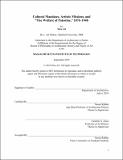Cultural mandates, artistic missions, and "The Welfare of Palestine," 1876-1948
Author(s)
Ari, Nisa.
Download1141856974-MIT.pdf (31.42Mb)
Other Contributors
Massachusetts Institute of Technology. Department of Architecture.
Advisor
Nasser Rabbat and Caroline A. Jones.
Terms of use
Metadata
Show full item recordAbstract
This dissertation investigates the changing landscape for artistic production in Palestine from the last decades of Ottoman rule until the establishment of the State of Israel (1876-1948). The development of new artistic practices and exhibition spaces occurred against a political backdrop in near constant transition--including the dissolution of the Ottoman Empire, the First World War, British military and colonial occupation (in the form of the British Mandate from 1920-48), as well as the growth of Arab nationalism and Zionism. Previous scholarship on Palestinian art defines it as a national artistic movement, born out of a state of political disenfranchisement after 1948. I argue instead that the conflicting ideological forces impacting Palestine in the early twentieth century produced the preoccupations and practices which define Palestinian art, and analyze how aspiring Palestinian artists, imperious foreign occupiers, moralizing evangelicals, international welfare agents, and Zionist immigrants contributed to its rise. The dissertation focuses on institutions supporting art's production and display, whose very presence reflected Palestine's complex political reality. These include, among others, the House of Industry created by Anglican missionaries for Jewish craftworkers in the late-1800s, the Supreme Muslim Council's First National Arab Fair for showcasing Arab arts and industry in 1933, and the Palestine Folk Museum initiated by British, Palestinian, and Jewish political representatives for collecting local costumes in the early 1930s. By identifying the role such entities played in the promotion of new artistic forms, as they encouraged the use of new material technologies from synthetic embroidery threads to photographic prints and dried flowers, I critically reevaluate the work of canonical early twentieth-century Palestinian artists including Nicola Saig, Sophie Halaby, Jamal Badran, and Zulfa al-Saʻdi. The dissertation finds that it was within a relatively short historical span that art production in Palestine changed from being used for religious and commercial ends in the late-1800s to being deployed for humanitarian and, eventually, political purposes by the 1930s. In doing so, it highlights Palestine as a compelling site for interrogating the previously unexamined origins of a "cultural sector" within the evolutions of nation-building, colonial pacification, and international humanitarianism following the First World War.
Description
This electronic version was submitted by the student author. The certified thesis is available in the Institute Archives and Special Collections. Thesis: Ph. D.: History and Theory of Art, Massachusetts Institute of Technology, Department of Architecture, 2019 Cataloged from student-submitted PDF version of thesis. Includes bibliographical references (pages 312-334).
Date issued
2019Department
Massachusetts Institute of Technology. Department of ArchitecturePublisher
Massachusetts Institute of Technology
Keywords
Architecture.